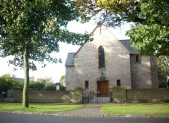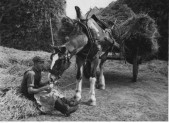The East Lothian village of Ormiston is noted for having been rebuilt as a model community by John Cockburn of Ormiston in the 1730’s. Having established an agricultural society for landowners and tenants to discuss improvements in farming and promoting linen manufacture, bringing skilled foreign craftsmen into Scotland to train his estate workers, John was […]
The Bevin Boys
Bevin Boys were young men between 18 and 25 who were chosen by ballot to serve in the mining industry. They were named after Ernest Bevin the wartime Minister of Labour and leader of the Transport and General Workers Union. The system employed by Ernest Bevin was that of a ballot scheme whereby young men […]
House O’ Muir
One and a half miles south west of Ormiston village at the junction of two by roads is a one storey building dating from the 17th Century. It is oblong in plan and measures 17 feet 8 inches x 48 feet over walls 2 and a half feet thick. The walls are roughcast and the […]
Ormiston Parish Church – Church of Scotland

The Kirk replaced another church close by at Ormiston House and was built in 1696 with a small but now extended burial yard. Mort safes were used to secure the dead and were reckoned to be of good construction. It is highly likely that George Wishart and John Knox preached in the church. It was […]
Land Use Around Ormiston

Agriculture was a prominent use of land until the unearthing of coal, nowadays, agriculture has reverted to being the most common land use. As mining methods improved, coal was extracted from the surrounding seams around the village. The village changed in size and character and many new houses were built. The Miners Welfare Institute was […]
Schools in Ormiston
In 1842, there were three schools within the Parish, one in the village, one at Peaston and one at the House of Muir. In 1845, there were no children between 6 and 15 years of age that could not read and write and most over the age of 15 could read but not all could […]
Historic Population of Ormiston
The population was around 550 in 1649, 863 in 1790, 766 in 1801, 727 in 1811, 779 in 1821 and, 838 in 1831.
The Meaning of Ormiston
The word Ormiston is derived from a Scandinavian settler called ‘Orm’. With the family ‘Orme’ having possession during the twelve and thirteenth centuries, hence the name of Ormiston. Ormiston or ‘Ormistoun’ as it was called formerly is not an uncommon surname. The latter part of the name is formally spelt ‘toun’ is likely to descend […]
The Locality and Topography of Ormiston Parish
The Parish of Ormiston is bounded by Humbie to the South, Pencaitland on the East, Tranent on the North and Cranston on the West. It is about 5 miles in length and very irregular in breadth, varying from 1.5 to about 0.5 mile; its narrowest part being on the Eastern extremity and it is broadest […]

Recent Comments